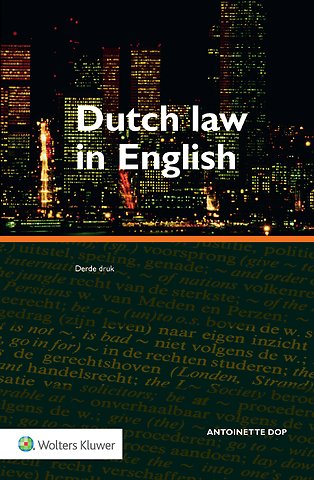



Antoinette Dop heeft Nederlands recht en notariaat gestudeerd en 'Recht en Linguïstiek'. Na haar studie heeft ze onder meer enige jaren als docent vermogensrecht en Romeins recht gewerkt en later als taaldocent.
Meer over Antoinette DopDutch Law in English
Samenvatting
Voor (aankomend) juristen is het essentieel in het Engels over hun vak te kunnen communiceren. Deze uitgave helpt je om Engelstalige vaktermen in de juiste context toe te passen, vol oefeningen gericht op het gebruik van de Engelse taal in uiteenlopende juridische contexten.
Als Nederlands jurist kun je niet om de Engelse taal heen. Effectief communiceren over het Nederlands recht in het Engels begint met de vertaling van typische Nederlandse juridische termen. Maar dat is niet genoeg: woorden komen immers pas tot leven als zij in hun context gebruikt worden. Een jurist heeft dus teksten nodig waarin juridische termen in samenhang worden gepresenteerd zodat ook duidelijk is hoe die woorden moeten worden gebruikt.
Dutch law in English levert hierin het noodzakelijke houvast. De titel levert vertalingen van Nederlandse juridische termen in het Engels en plaats deze steeds in de juiste context, zodat de lezer kan zien hoe de woorden gebruikt kunnen worden. Het is daarmee een onmisbaar hulpmiddel voor (aankomend) juristen die effectief willen communiceren in het Engels over het Nederlandse recht. Daarnaast is de publicatie geschikt als naslagwerk voor juridisch Engels in de internationale rechtspraktijk.
Juridische termen Engels
De titel voorziet in vertalingen en context van uiteenlopende juridische termen waar je als jurist mee te maken hebt. Je treft een Engelstalige inleiding tot diverse belangrijke rechtsgebieden zoals verbintenissenrecht, vennootschapsrecht en strafrecht. De auteur slaagt erin de nadruk te leggen op typerende terminologie, zonder daarbij de samenhang tussen de verschillende juridische thema’s uit het oog te verliezen. Elk hoofdstuk wordt afgesloten met gevarieerde oefeningen, gericht op het verbeteren van Engelse taalvaardigheid in de juridische context.
Introduction into legal English
Dutch law in English stond voorheen bekend onder de titel ‘Introduction into Legal English’.
Trefwoorden
Specificaties
Inhoudsopgave
1.1 Civil law and common law, introduction / 1
1.2 Civil law: history / 2
1.3 History of common law: The establishment of a centralised administration of justice / 3
1.4 No codification / 4
1.5 Sources of law in common law / 5
1.5.1 Common law and equity / 5
1.5.2 Statute law and common law / 6
1.5.3 The legal profession / 7
1.6 This book / 7
Exercises chapter 1 / 9
2 FAMILY LAW / 17
2.1 Law of parentage / 17
2.1.1 The creation of legal family ties / 18
2.1.2 The establishment of legal parenthood: by operation of law / 18
2.1.3 The establishment of parenthood: not by operation of law / 19
2.2 A child’s name / 20
2.3 Parental responsibility and minority / 21
2.4 Legal capacity / 23
2.5 Obligation to provide maintenance / 23
2.6 Majority and protective intervention orders / 24
Exercises chapter 2 / 26
3 MARRIAGE, COHABITATION AND REGISTERED PARTNERSHIP / 29
3.1 Cohabitation contracts / 29
3.2 Registered partnership / 29
3.3 Patrimonial family law and mutual spousal obligations / 30
3.4 Spouses and third parties / 31
3.5 Family assets and liabilities / 33
3.5.1 End of the family assets and liabilities / 34
3.6 Marriage contract / 34
3.7 End of the marriage, including divorce / 35
3.8 Consequences of divorce / 36
Exercises chapter 3 / 37
4 LAW OF OBLIGATIONS I: JURIDICAL ACTS AND CONTRACTS / 41
4.1 The juridical act: general remarks / 41
4.1.1 The creation of the juridical act: legal capacity to act, disqualification and the declaration of intent / 41
4.1.2 The moment of creation of the juridical act / 42
4.1.3 Void and voidable juridical acts / 43
4.2 The contract / 44
4.2.1 The formation of a contract / 45
4.3 Error: void and voidable contracts / 47
4.4 The contents of the contract / 49
4.4.1 Interpretation and legal consequences of a contract / 50
4.4.2 Relationship of the parties prior to the conclusion of the contract / 51
4.5 Performance of the contract or non-performance / 52
4.5.1 Rights to suspend performance / 52
4.6 Non-performance / 53
4.5.2 Imputable non-performance / 53
4.7 Non-performance which cannot be imputed: force majeure / 55
Exercises chapter 4 / 59
5 LAW OF OBLIGATIONS II: TORT AND COMPENSATION / 71
5.1 Tort: Requirements / 71
5.1.1 Attribution / 73
5.1.2 Causality and damage / 74
5.1.3 Protective norm / 74
5.2 Claims based on tort / 74
5.3 Qualitative liability and strict liability / 75
5.3.1 Liability for children / 75
5.3.2 Liability for subordinates (article 6:170 DCC) / 76
5.3.3 Liability for objects / 76
5.3.4 Product liability / 78
5.4 Compensation / 80
5.4.1 Damage and causality / 80
5.4.2 The compensation of ‘other prejudice’ / 83
Exercises chapter 5 / 84
6 LAW OF PROPERTY / 93
6.1 General characteristics of the law of property / 93
6.2 Limited rights and qualitative rights and duties / 96
6.3 Ownership, detention and possession / 97
6.4 Acquisition of ownership / 98
6.4.1 The acquisition of ownership of choses by transfer / 99
6.4.2 Third party protection for movable choses / 102
6.4.3 Third party protection for immovable property / 103
Exercises chapter 6 / 105
7 SALE / 111
7.1 Conclusion of the purchase contract / 112
7.2 The seller’s obligations / 113
7.3 Defects and conformity with the contract / 114
7.4 Reversal of the onus of proof and guarantees / 117
7.5 Non-performance by the seller and duty to complain of the buyer / 118
7.6 Compensation and a special type of non-conformity with consumer sale: the safety defect / 121
7.7 Buyer’s obligations / 122
7.8 Non-compliance by the buyer / 123
7.9 The right to reclaim / 124
Exercises chapter 7 / 125
8 LABOUR LAW / 131
8.1 Features of employment contracts / 131
8.2 Alternative contracts regarding work / 132
8.3 The creation of the employment contract / 134
8.4 Special provisions in employment contracts / 136
8.5 The employee’s duties / 137
8.6 Employer’s sanctions in the event of non-compliance by the employee / 138
8.7 The employer’s duties / 139
8.8 Employee sanctions / 140
8.9 No labour, no wages. Exceptions / 140
8.10 Law on termination / 141
8.10.1 Ending an employment contract by giving notice / 142
8.10.2 Is the permit to give notice always required? Dismissal bans / 143
8.10.3 Term of notice / 143
8.10.4 Dismissals and compensation / 143
8.10.5 Termination for a substantial reason / 144
8.10.6 Termination of an employment contract before the court / 145
8.10.7 Termination of an employment contract by operation of law / 145
8.10.8 Termination of an employment contract by mutual consent (termination contracts) / 146
Exercises chapter 8 / 148
9 COMMERCIAL LAW I: GENERAL ASPECTS / 153
9.1 Representation and procuration / 153
9.2 Commercial register / 156
9.3 The duty to keep accounting records and the law on annual accounts / 157
9.4 Bankruptcy / 158
9.4.1 The estate in bankruptcy / 159
9.4.2 The estate and contracts / 161
9.4.3 End of the bankruptcy / 162
9.4.4 Act on the Approval of a Private Deed Concerning a Composition / 162
Exercises chapter 9 / 164
10 COMMERCIAL LAW II: JURIDICAL PERSONS / 167
10.1 To carry out business activities or a profession without juridical personality / 167
10.1.1 Sole proprietorship / 167
10.2.2 Personal partnerships / 168
10.1.3 Partnerships / 168
10.1.4 Partnership under a common firm / 170
10.1.5 Limited partnership / 172
10.2 Juridical persons / 172
10.2.1 Limited liability companies and private limited liability companies / 173
10.2.2 Formation and capital / 174
10.2.3 Shares / 176
10.2.4 The company’s organs / 177
10.2.5 Association, co-operative society, mutual insurance association / 180
10.2.6 Co-operative society and mutual insurance association / 181
10.2.7 Foundation / 182
10.3 Resolutions of juridical persons / 183
Exercises chapter 10 / 185
11 ADMINISTRATIVE LAW AND SOME ASPECTS OF CONSTITUTIONAL LAW / 191
11.1 The Netherlands and the rule of law / 192
11.2 Attribution, delegation and mandate / 193
11.3 Public bodies, offices, and administrative bodies / 194
11.4 The decentralised unitary state / 195
11.4.1 Organisation of municipalities / 196
11.4.2 Organisation of the provinces / 198
11.4.3 Water boards and other public bodies / 200
11.5 Orders / 201
11.5.1 Decisions / 202
11.6 Public law or private law? / 204
11.7 Enforcement and sanctions / 204
11.8 General principles of proper administration / 206
11.9 Remedies / 208
Exercises chapter 11 / 211
12 CRIMINAL LAW / 215
12.1 Offences / 215
12.2 Perpetratorship / 216
12.3 Intent / 217
12.4 Culpa / 219
12.5 Defences / 220
12.6 Criminal attempt / 223
12.7 Criminal participation / 225
12.7.1 Co-perpetration / 226
12.7.2 Incitement / 227
12.7.3 Complicity / 228
12.8 Public Prosecution Service / 228
12.9 The investigation / 229
12.10 The trial / 232
12.11 The preliminary questions of article 348 Dutch Code of Criminal Procedure / 233
12.12 Sanctions / 235
12.12.1 Principal punishments and additional punishments / 235
12.12.2 Non-punitive measures / 236
Exercises chapter 12 / 238
KEY / 245
DEFINITIONS / 279
INDEX / 293
WOORDENBOEK / 299
Anderen die dit boek kochten, kochten ook
Net verschenen
Rubrieken
- aanbestedingsrecht
- aansprakelijkheids- en verzekeringsrecht
- accountancy
- algemeen juridisch
- arbeidsrecht
- bank- en effectenrecht
- bestuursrecht
- bouwrecht
- burgerlijk recht en procesrecht
- europees-internationaal recht
- fiscaal recht
- gezondheidsrecht
- insolventierecht
- intellectuele eigendom en ict-recht
- management
- mens en maatschappij
- milieu- en omgevingsrecht
- notarieel recht
- ondernemingsrecht
- pensioenrecht
- personen- en familierecht
- sociale zekerheidsrecht
- staatsrecht
- strafrecht en criminologie
- vastgoed- en huurrecht
- vreemdelingenrecht





